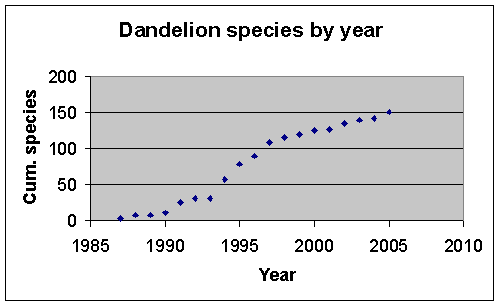Worcestershire Record No. 20 April 2007 pp. 43-51
Bert Reid
Before the Flora Project started in 1987, very little was known about Worcestershire’s dandelion species. All we had were 22 expert determinations covering 14 species. British dandelions are apomictic, producing seed asexually with each seedling being a clone of its mother. Each mutation can create a new microspecies if the plants survive natural selection. About 240 such species have been found in the British Isle. Identification of Taraxacum microspecies is very difficult with a large number of similar species each of which varies considerably in appearance according to age, season, nutrient level, soil type, insolation and other factors.
We have made considerable efforts to improve our knowledge of which dandelions are present in our area and as far as possible find out about their local distribution and ecology. The problems of identification meant that little progress was made until the early 1990s when Bert Reid contacted the national experts John Richards and the late Andrew Dudman. They looked at the specimens we had collected and advised us on what to collect, how to collect it and how to prepare suitable vouchers. Without their great help and support our progress would have been insignificant. John Richards has identified more than 1,200 specimens for us, and has looked at many more that could not be identified because of our poor selection, collection and preparation. This has enabled us to build up a local reference collection of expertly determined species and has raised the species count from 14 to 151. The progress of post 1987 species counts by year is shown in the graph below.
This large number of species is difficult to fit into the new flora of Worcestershire that is currently in preparation. Full accounts of each Taraxacum species with distribution maps, ecological data, historical and national perspective etc. would take up an inordinate amount of space. It has been decided that the account in the book should concentrate on the words and that the species maps should be kept to a minimum. Our knowledge of local dandelion distribution is very much a work in progress and in some cases, especially with the ruderal species, the mapped distribution may say more about where collectors have been than about genuine distribution patterns. We have therefore decided to publish the dandelion maps to the end of 2005 here separately.
The sequence of species and the Latin names follows Dudman and Richards 1997 (the Handbook), except for T. dahlstedtii H. Lindb., which is now known as T. stenoglossum Brenner. Unpublished work names in the Handbook are included as are two further work names coined by Tom Edmondson (T. ‘chrysospinum’ and T. ‘pseudocroceiflorum’) that appear as the final two maps.
The British dandelions are split into nine sections. Two of these, sections Obliqua and Taraxacum, are not found in our area, being restricted to coastal habitats and high mountains respectively. All the other sections are represented in Worcestershire. We have 13 species in section Erythrosperma (maps lacistophyllum to glauciniforme) mainly small species restricted to short, dry grassland habitats. The next two maps (palustre and anglicum) are from section Palustria, scarce native species restricted to fens and seasonally wet grassland. These are followed by faeroense, the only mainland species in section Spectabilia. We have three species from the mainly northern and western section Naevosa (europhyllum to richardsianum) followed by 17 in the mainly western section Celtica (gelertii to unguilobum). The final two sections are both mainly ruderal: Hamata with 16 species (hamatum to lamprophyllum) and the large section Ruderalia with 99 species (laeticolor to ‘pseudocroceiflorum’. The Ruderalia have been split into three for the web-site: Ruderalia 1(laeticolor to acutifrons), Ruderalia 2(chrysophaenum to aurosulum) and Ruderalia 3 (lunare to ‘pseudocroceiflorum’) Each map shows the known tetrad distribution in Greater Worcestershire. The grid shows hectad (10 km square) boundaries from the OS Maps. Dark green dots are records from 1987 to 2005 with paler dots signifying earlier records.
Reference:
| Dudman, A.A. & Richards, A.J. 1997. Dandelions of Great Britain and Ireland. Botanical Society of the British Isles Handbook no. 9. London: Botanical Society of the British Isles. |

| WBRC Home | Worcs Record Listing by Issue | Worcs Record Listing by Subject |